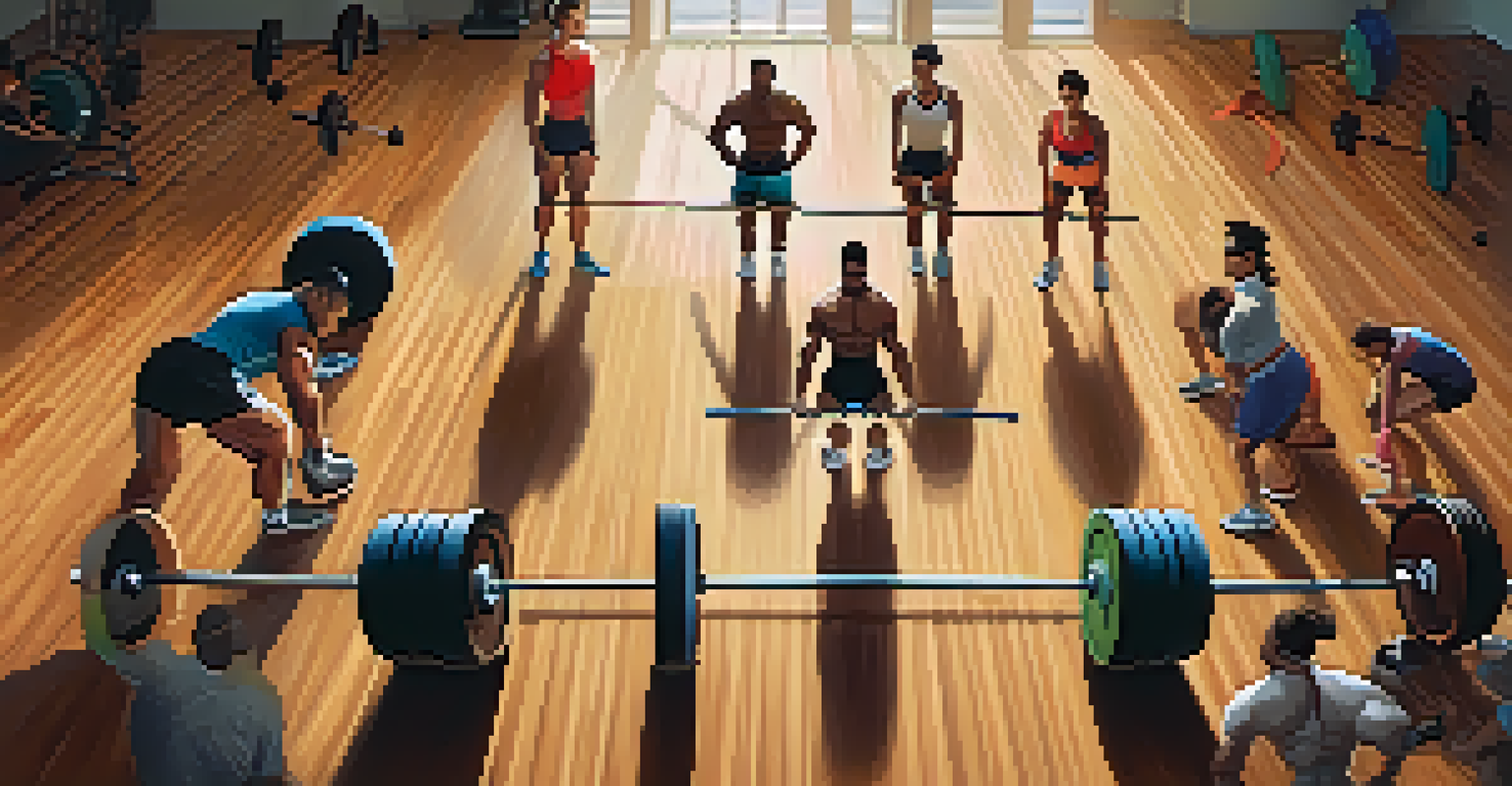Deadlifts: A Game-Changer for Athletic Performance Gains

Understanding the Deadlift: What Makes It Special
The deadlift is a compound exercise that targets multiple muscle groups, making it unique in the fitness world. Unlike isolation movements that focus on one muscle, deadlifts engage your legs, back, and core all at once. This synergy not only builds strength but also improves overall functionality in athletic performance.
Strength does not come from physical capacity. It comes from an indomitable will.
Picture lifting a heavy box off the floor—it's not just about your arms; your legs and back play crucial roles too. This is the essence of the deadlift, training your body to work as a cohesive unit. By mastering this lift, you're not just building muscle; you're enhancing your body's ability to perform in sports and daily activities.
Moreover, deadlifts increase your grip strength, which is vital in many sports, from rock climbing to football. So, whether you’re sprinting down the field or lifting weights, deadlifts prepare your body for the challenges ahead.
Boosting Strength and Power with Deadlifts
One of the most significant benefits of deadlifts is their ability to build raw strength. As you progressively lift heavier weights, your muscles adapt, leading to increased power output. This is especially beneficial for athletes who need explosive strength in their respective sports, such as sprinters or weightlifters.

Think of deadlifts as a foundation for strength training—like laying down solid ground before building a house. Without this base, other lifts may not be as effective. As your deadlift improves, you’ll likely notice boosts in your performance across various workouts and competitions.
Deadlifts Build Total Body Strength
As a compound exercise, deadlifts engage multiple muscle groups, enhancing overall strength and athletic performance.
Additionally, deadlifts engage your central nervous system, which can enhance your overall athletic performance. When you lift heavy, your body learns to recruit more muscle fibers, contributing to increased strength gains.
Improving Posture and Stability Through Deadlifts
Deadlifts are not just about lifting heavy weights; they also promote better posture and stability. In today's world, where many of us are hunched over screens, deadlifts can counteract those negative effects. By strengthening your back and core, you create a solid foundation for your upper body, which translates to improved posture.
The difference between a successful person and others is not a lack of strength, not a lack of knowledge, but rather a lack in will.
Imagine standing tall with confidence, thanks to stronger muscles supporting your spine. This improvement in posture can help prevent injuries, particularly in sports that require agility and quick movements. When your body is aligned, you move more efficiently.
Furthermore, stability gained through deadlifts can enhance your performance in dynamic sports. Whether you’re changing directions quickly in basketball or maintaining balance in gymnastics, a strong core and back will give you the edge you need.
Enhancing Athletic Endurance with Deadlifts
While deadlifts are often associated with strength, they also play a role in building endurance. When performed in higher repetitions with moderate weights, deadlifts can condition your muscles to perform longer without fatigue. This is particularly advantageous for athletes involved in endurance sports, such as long-distance running or cycling.
Visualize your muscles as a car engine—by training them to handle heavier loads, you're effectively increasing their capacity. This means you can push through longer competitions or training sessions without feeling drained. It’s about developing not just strength but also the stamina to sustain that strength over time.
Improved Posture and Stability
By strengthening the back and core, deadlifts promote better posture and stability, crucial for efficient movement in various sports.
Moreover, the metabolic boost from incorporating deadlifts into your routine means you'll burn more calories, aiding in recovery and overall fitness. This dual benefit makes deadlifts a smart addition to any athlete's program.
Injury Prevention Through Proper Deadlift Technique
One of the most compelling reasons to incorporate deadlifts into your training is their injury prevention benefits. When performed correctly, deadlifts can strengthen the muscles around your joints, providing better support during athletic activity. This is crucial in sports, where twists, turns, and sudden movements can lead to injuries.
Consider deadlifts as a form of prehabilitation—training your body to withstand the stresses it faces during competition. By focusing on proper form, you not only maximize your gains but also minimize the risk of injury. It's like wearing a seatbelt; it may seem restrictive, but it protects you in case of an accident.
Additionally, developing a strong posterior chain through deadlifts helps with overall body mechanics. A well-balanced body means less strain on specific muscles and joints, leading to a healthier and more resilient athlete.
Deadlifts and Their Impact on Mental Toughness
Engaging in deadlifts not only challenges your body but also your mind. The focus and discipline required to lift heavy weights can translate into mental toughness in other areas of life, including sports. Each successful lift builds confidence, pushing you to tackle not just physical challenges but mental barriers as well.
Think of deadlifts as a metaphor for overcoming obstacles. Just as you lift heavier weights, you also learn to face and conquer challenges head-on. This boost in self-efficacy can enhance performance in competitions, where mental resilience is just as crucial as physical strength.
Mental Toughness Through Lifting
The discipline and focus required for deadlifts help build mental resilience, boosting confidence and performance in sports.
Furthermore, the satisfaction of achieving a new personal record can be incredibly motivating. This sense of accomplishment fosters a positive mindset, encouraging athletes to strive for continuous improvement both in and out of the gym.
Incorporating Deadlifts into Your Training Regimen
To reap the benefits of deadlifts, it’s essential to incorporate them effectively into your training regimen. Start with proper warm-up exercises to prepare your muscles and joints for the workout ahead. This can include dynamic stretches and lighter lifts to ensure you’re ready to tackle heavy weights.
As you begin, focus on mastering your form before increasing the weight. A well-executed deadlift is more beneficial and safer than lifting heavy with poor technique. Don't hesitate to seek guidance from a coach or watch instructional videos to understand the nuances of the lift.

Finally, remember to listen to your body. Allow adequate recovery time between sessions to prevent overtraining. By consistently incorporating deadlifts into your routine, you’ll notice significant improvements in your athletic performance over time.